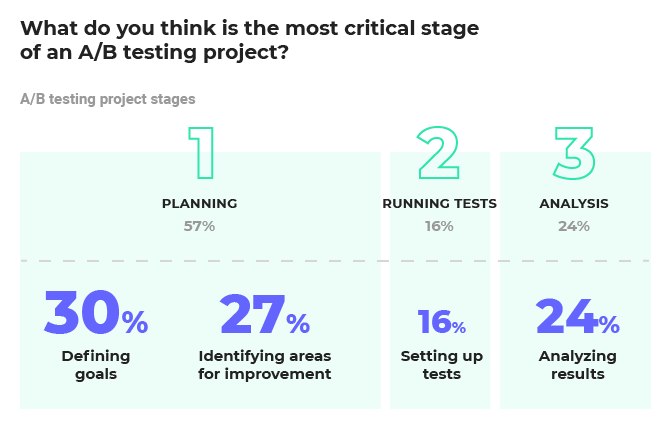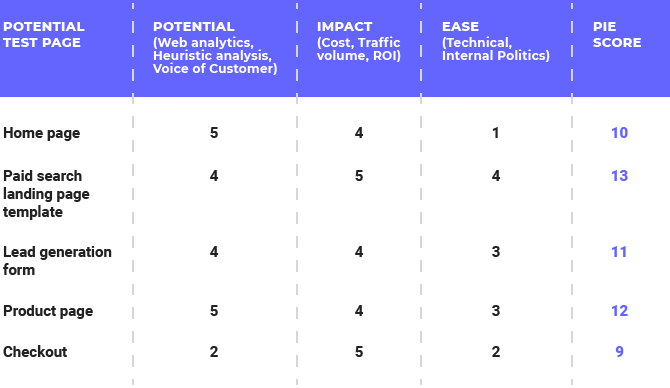
Four steps to build your testing roadmap
If you want to run a successful experimentation program then optimizing your processes is just as important as the actual A/B tests that you run. Prioritizing your actions will allow you to get the best results from your testing program – therefore, in this article, we’ll outline the four essential steps to creating a successful A/B testing roadmap.
Once you’ve decided to start your conversion rate optimization campaign, the first question to ask is where to focus first when you begin the program.
This is because for traffic distribution and statistical significance reasons, you shouldn’t test all of your pages at the same time. That’s why, even if you want to A/B test your entire website, it’s essential to know how to prioritize and rank your plans before starting.
That’s why having a roadmap is vital - it is essential to the process of optimizing your website. It will enable you to create, communicate and effectively share your strategy in such a way that you can mobilize and coordinate your wider team and ensure you achieve your goals.
So how should you go about drawing up a roadmap to help you run efficient and effective campaigns?
1 Define the goal of your experimentations
Goal setting: the most difficult step in the experimentation process
According to a panel of marketers interviewed by Kameleoon on A/B testing and personalization, the most critical step in an A/B testing project is defining your test goals.

Planning (goal setting and identifying areas for improvement) is considered critical by 57% of respondents.
This is completely logical. In fact, the thinking time before starting to implement your tests is what determines their future success. For a smart, relevant campaign, you need to predetermine the triggering elements and barriers to achieving your goal (whether that is conversion, subscription or clicks for example).
And if you want your analysis to be relevant, take your time to think it through first: if you don’t properly determine your goals and reasons for running a test, then you’ll probably have problems determining its failure...or its success.
What are the most commonly shared goals for running A/B tests?
According to our panel, these goals focus first and foremost on usability and landing pages. Within these two main categories, the goals are then further refined, depending on your brand’s line of business, market and audience.
2 Define your experimentation KPIs
Once you’ve decided on your strategic and marketing goals, you’ll have to determine the primary and secondary Key Performance Indicators (KPIs) to monitor. This is not optional: without KPIs, it is impossible to gauge the success of the test once it’s completed. However, before you choose the tools to monitor the KPIs, make sure you really understand the browsing data on your website.
Although it can be difficult, if you want to run data-driven tests, it’s a good idea to actually understand the data. After all, a superficial analysis of your website could lead to major strategic mistakes. For example, if one of the goals defined by a marketer is to increase the number of downloads of a resource, it is possible to rush to change the wording of the CTA. But it is also probable that the lack of conversions comes from a less obvious barrier, which needs to be analyzed in depth.
This approach isn’t about minimizing the importance and impact of surface changes to a website: these can be extremely efficient in terms of conversions and can represent a very positive gain/cost benefit. But before making these types of changes, be sure they truly help you achieve your macro goals. To determine this, you will need to draw up an analytical and UX audit.
3 Prioritize your tests in your experimentation road map
All these analyses will give you a multitude of ideas for tests but you can’t run all of them simultaneously. So how should you prioritize them? It normally depends on your website and your goals.
PIE MODEL : PRIORITIZE WITH A WEIGHTING TABLE
According to the PIE prioritization framework, you need to consider three criteria in prioritizing which pages to test and in which order. They are as follows :
- Potential: what are the chances of increasing your conversion rate?
- Impact: if the page doesn’t have much traffic, the value of an optimization is corresponding low.
- Ease (of implementation): tests that are easy to put in place can save time and deliver results more quickly.
You can quantify each of your potential opportunities based on these criteria to create your test priority list. The most important consideration is the importance of the pages to the company, with the highest volume and costliest traffic.
If you have multiple test opportunities you can prioritize, use a weighting table to help with the decision. List your potential test pages in the first column, and add your rating using a scale of 1-5 in the Potential, Importance, and Ease columns. Then, total the columns to provide an overall score, as shown below:

Establish the difficulty of a test
Two criteria matter for establishing how difficult a test is to run: the graphical changes and functional modifications that are required. We categorize tests into three levels of difficulty:
- A simple test implies few graphic changes on one or several pages, which don’t require any particular technical skills to make, such as modifying text, colors, product visuals, size of action buttons, moving blocks, redirection to a new page or bannering.
- An advanced test involves few functional changes but advanced graphic changes, and requires reasonable skills in CSS and HTML, for example, changing a product list from 3 to 2 columns, reorganizing a navigation menu, deleting a form field, redirecting an URL to several pages or adding a CTA.
- A complex test implies significant functional changes and solid experience in web techniques (such as JavaScript). These could include changing a redirection to a page to an overlay display with a pop-up opening, general redesign of all product information pages, moving away from a purchase form with several steps (without URL redirection) or shortening a conversion funnel.
4 Communicate your results!
The success of an A/B testing project will greatly depend on your capacity for team work, bringing in people from different departments in your organization. While you clearly need to involve the marketing team, you will also need the IT department and sales people, for example. Remember that everyone can contribute something from their own area of expertise and improve the tests.
What actions should you take to create good group dynamics?
BEFORE THE TEST
Draw up a document that summarizes all the elements of the test, including these important points:
The reasons for the test: strategic, marketing and sales goals
The KPIs chosen
The way the test is integrated into the website
AFTER THE TEST
Communicate the results to your team – whether successful or not. They will then feel more invested in what comes next and more capable of understanding the benefits of conversion optimization.
Keep your roadmap safe. These test plans will be useful for keeping an eye on your website’s evolutions and giving you ideas for your next tests.
5 Creating an A/B testing roadmap: summary
There is no golden rule for accurately determining which type of pages to prioritize first, because your website will have specific characteristics and goals based on your particular market, audience and internal organization. And while you can run A/B tests without a roadmap they will have a lesser impact.
However, applying the rules in this article will help determine the goals of your conversion optimization practice, and thus the priority level given to each page of your website, helping ensure a greater chance of a successful testing program.




